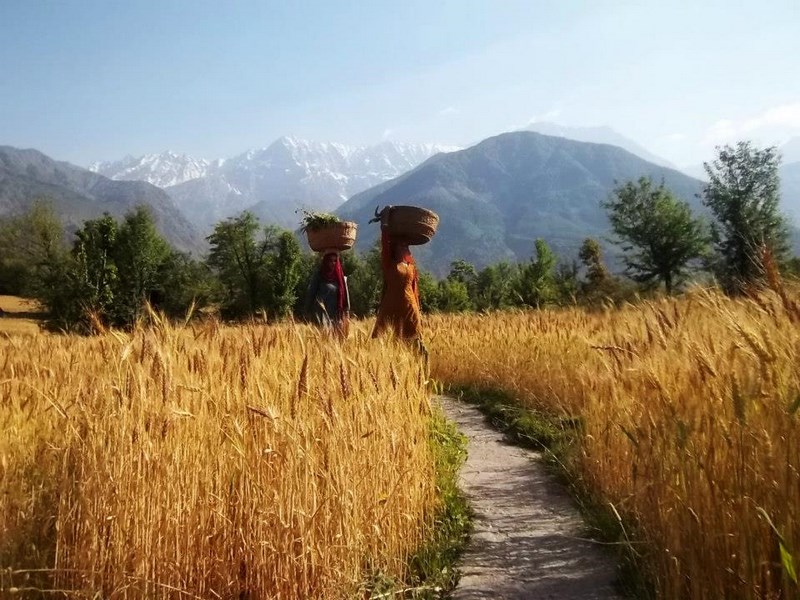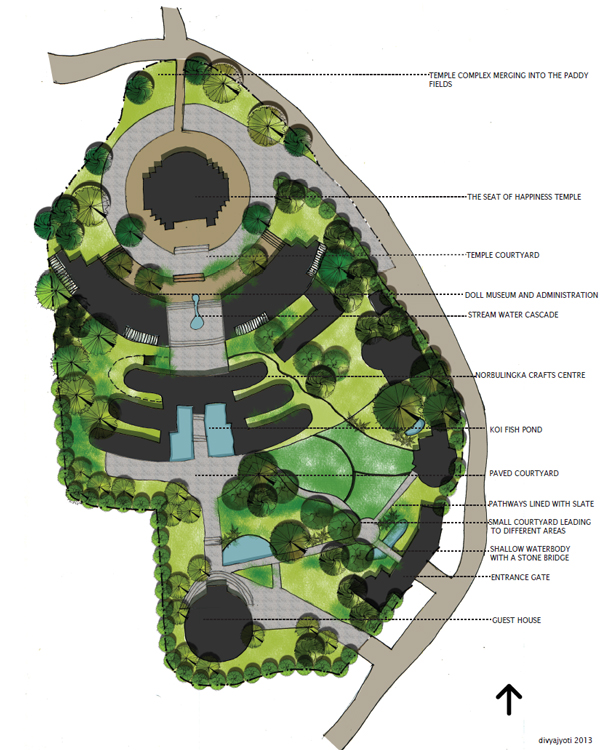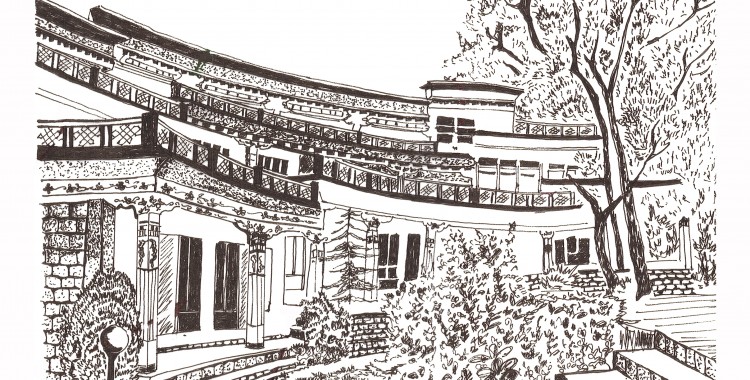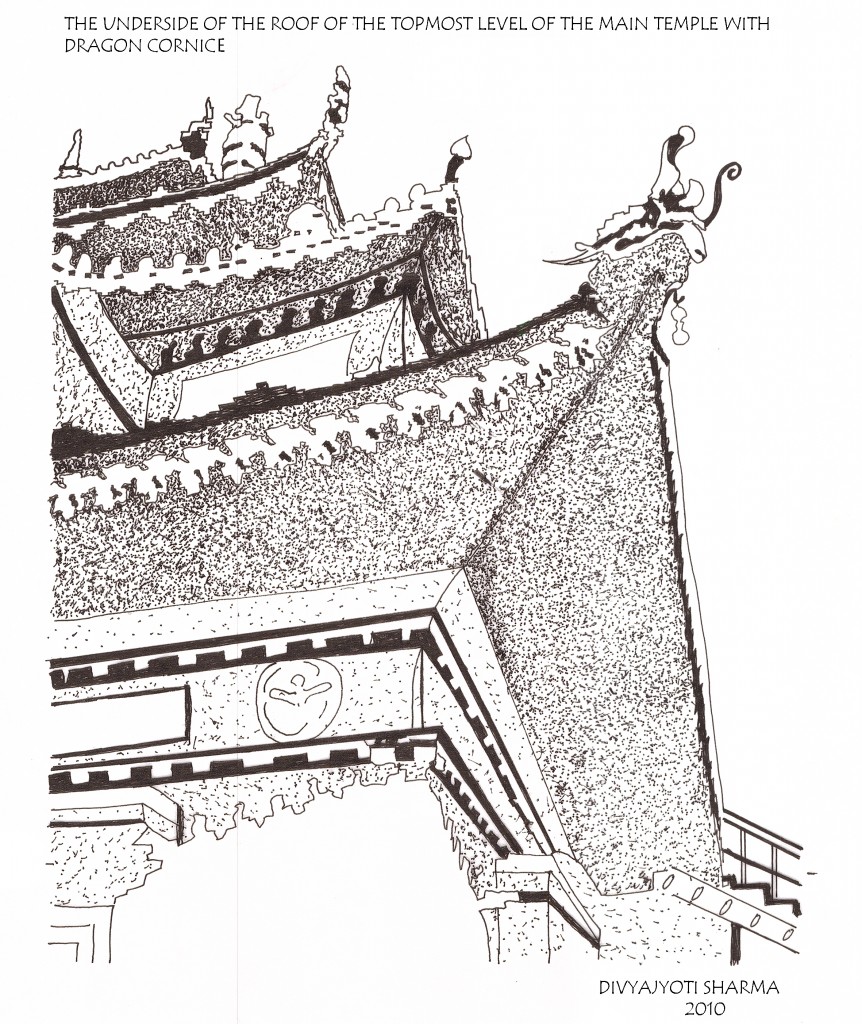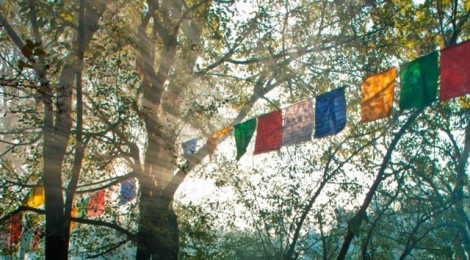
A Borrowed Garden
This is a stunning piece of research and writing by Divyajyoti Sharma – a Landscape Architect in BDP’s New Delhi studio. This piece has recently featured in the Journal of Landscape Architecture. Aiming to pursue her masters in Landscape Architecture, she is an adorer of nature and loves to record and write about it. Divyajyoti Sharma can be reached at : divyajyotisharma@hotmail.com
Some images will require enlarging to view the full extent; to do this, please click on an image you wish to view.
Tashi Delek!
Though in a borrowed garden
you grow, grow well my sister.
This Losar
when you attend your Morning Mass,
Say an extra prayer
that the next Losar
We can celebrate back in Lhasa.
When you attend your convent classes
Learn an extra lesson
That you can teach children back in Tibet.
Though in a borrowed garden
you grow, grow well my sister.
Send your roots
Through the bricks,
stones, tiles and sand.
Spread your branches wide
and rise
above the hedges high.
Tashi Delek!
—Tenzin Tsundue, Losar Greeting
The Journey across the mighty Himalayas
Pastoralism in adverse landscapes has been associated with the bucolic man since history started being time -lined. Man along with his livestock and culture has wandered across deserts, climbed mountains, crossed mighty rivers and has finally led to the formation of small patches of humanity on the skin of Earth’s unexplored places.
Years ago, a time was recorded in the historical archive when these Yak Pastoralists under the Holy Dalai Lama started migrating towards the Western Himalayas, into India due to the Chinese suppression in their homeland. This movement was termed as the “Great Lhasa Shift“. Along with these ‘refugees in exile’ flowed their tradition and ways of living, which gave India yet another colourful and vibrant boost of rich mountain culture. These colours started infusing into the country’s air as they started occupying the heights of the’ Dhauladhars’- The Himalayan arm that spreads across the state of Himachal Pradesh.
The most precious pieces of art and architecture have been found in the deepest crevices of the earth, Norbulingka Institute being one, neatly tucked into the folds of the Dhauladhars, in the local district of Kangra. The high road to Norbulingka from New Delhi is a scenic byway, passing through classic landscapes of all times: the leeward scrub vegetation , the expansive Himalayan river banks, dense deodar and pine forests, light green corn and paddy fields, tiny villages nestled along the sinewy slopes, lush green tea gardens and serene lakes.
The Himalayas are an abode to both Hinduism and Buddhism and these snow capped mountains form the most fascinating backdrop to the Norbulingka Institute, which was founded in 1988 by Kelsang and Kim Yeshi to preserve Tibetan culture, traditional arts and to bridge the gap between the new and the old Tibet, where the refugees in exile were given work, food and shelter.
The Seeds of concept
A site initially a vast paddy field, was chosen for Norbulingka. A Japanese architect Nakahara laid down the initial stones of conceptualization of the buildings and the landscape of Norbulingka, which to a very large period remained scattered and the complex appearance random and unorganised. The need for landscape arose from the very emergency of stitching these scattered beads of design into a thread of unity that tailored the entire complex- the buildings and the nature around, into a single cloak of serenity and beauty. Japanese Zen garden was the trigger to the landscape concept and the aim was to rediscover peace with the slightest touch on the borrowed land far away from home and to let it foster beautifully, nurture nature within itself and continue to inspire the acquired home. The region of Tibet is a vast dry desert and could not be inspirational enough for Norbulingka which was to come up in the green and moist Valley of Kangra. The garden was supposed to be a derivation of the Buddhist principles, was to reflect religion and spiritualism and yet exist as a suited piece of design in the surroundings of the valley. Also called the Jewel garden, the original one being in Lhasa, follows the guidelines of a Japanese garden laying emphasis on water and stone but reflects itself through a palette of local landscape elements, material and planting of the region.
Weeding Off of challenges
In 2003, Kim Yeshi approached a young designer called Dhruv Chandra Sud to finally give shape and dimension the Norbulingka Institute.The basic role of the architect designer was to investigate the dis-integrated masterplan and consolidate it through a landscape strategy. The landscape did not follow the conventional design process, the canvas of representation was not paper or software but the nature itself, all design and construction decisions were taken on the site collaboratively by the architect and the founder. The natural environment controlled every move the designer made. The breeze, the topography, the rain, the sun and the light were the driving wheels of the design carriage throughout. Every gesture made on the site was an outcome of a deep analysis and a thought process, which involved hands on work with the unskilled local labor.
The design harvest
The landscape for the Norbulingka Institute can be described as a layered one, it is sheathed by a historical layer laid down by Nakahara, which had to be archaeologically unfolded to be restored or redirected into a better design. The second layer which covered Norbulingka was the spatial layer which was derived out of the spaces and building blocks having different functions. Layer three was an attempt to follow the local design vocabulary, explore the native practices and outdoor elements of space design and reflect the same in the Norbulingka landscape design. The landscape here is an interwoven fabric of the art of design and the craft of horticulture. The landscape recognizes the spirit of the place which is both unique and fragile. “The thought process on creating this beautiful habitat seemed to mirror the broad Japanese idea of distilling nature down to garden scale.” It was within this Buddhist philosophical approach that the Norbulingka garden served to open us up to taking another look at our lives in the wider perspective…such that it became a garden of regional character.
The zoned up slope
The entrance: Today as one approaches the Norbulingka Institute from a narrow village road, he begins to feel the transition within and outside him. The serenity of the place completely takes over the senses and enthrals the visitor completely. The gurgling sound of the village Brooke flowing underneath the entrance bridge welcomes you and guides you to this abode of heaven through a heavily ornated entrance of Tibetan style.
The non-official buildings: Moving further, the gurgling sound of the stream welcomes you; a pathway unrolls and leads you into a courtyard surrounded by a café on one side and an extension of the entrance on the other. The site being a sloping one, this is the lowest zone at the site. The café seating overlooks a water body, formed by the numerous water streams which drain the entire site into it. Nature is constantly trying to grow into the pool of water, with reeds and tropical vegetation as the vanguard. Moving upwards along the convoluted pathways one comes across streams, climbs up steps, crosses small bridges and reaches the next level. Here, small clear patches of site have been covered with flagstones, some of which rise up to form seats or benches. Moving against the flow of water, up the hill, one finds small structures made up of stone stacks called Manidungs which are scattered all over. These are typical to the Buddhist philosophy and continuously act as a reminder of the spiritualism of the place. Colorful votive prayer flags are hung tree to tree all over the place.
The Workshops and the Doll Museum: Moving deeper into the complex, through a stony bridge over a huge Koi fish pond we finally reach the third zone of the site. The sound of the water becomes more prominent here because it incessantly falls over a stony plinth and finally into the bigger pool through beautifully carved lion head spouts. To our right is the Norling gift shop and to our left lies the Doll museum. The workshops have a small paved courtyard with grey and blue colored mountain slate; which lacks the loose texture of the gravel at the lower levels. The stream here is a small water channel which continues to cascade down to the lower water bodies dividing the court into two.
The Temple: The uppermost zone is the courtyard of the Seat of Happiness temple which has been paved to house gatherings and religious functions. Natural grass joints have developed in between the slates. On the edges of the courtyard is a long strip of planting beds with seasonals. Huge Celtis tetrandras act as a canopy to this open space. As we move up the hill the complex design starts to slowly merge into the green paddy fields and finally the mountain slopes.
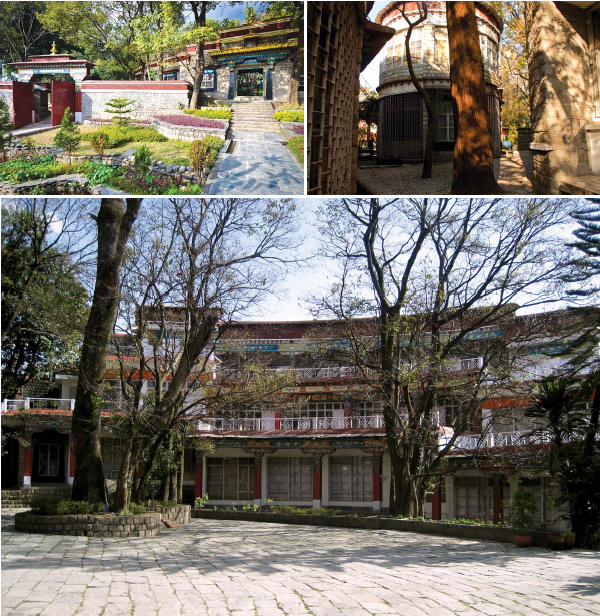
Moving clockwise from top left: The entrance, The dry side of landscape, and Temple court paved with mountain stones and shaded by huge khirks. Photo source: Divyajyoti Sharma
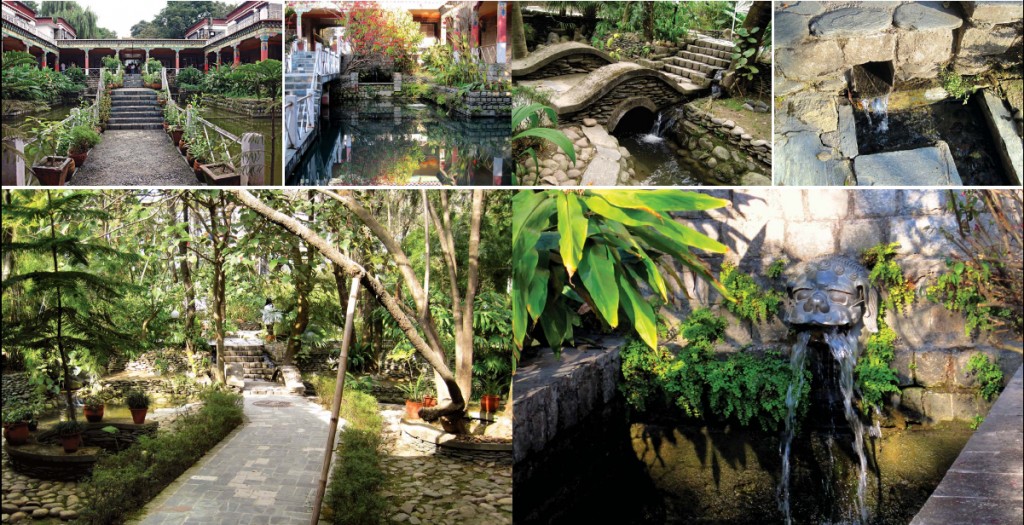
Please click the image to enlarge. Moving clockwise from top left: The entrance lobby to the main temple, The Koi fish pond, stone bridge over the stream, the water channel, pathways leading deeper into the campus and water spouts or gargoyles. Photo source: Divyajyoti Sharma
As a single entity
“A garden, if you think about its plan from above, is a series of shapes- of grass, of water and of planting.” The organic shapes used have a relationship to the pattern of their surroundings. Eventually, a garden design becomes an exercise in mass and void, built up from the interrelationship of elements of a scaled ground pattern. At Norbulingka, organic shapes are simulating landscape patterns – the flow of a meandering stream, a small pathway, the edge line of a pool or the growth pattern of natural vegetation. The garden with sinewy landforms and elements sits in utmost juxtaposition with the hill landscape around.
The site as it winds across
The natural contours of the site were like flexible wires, at places they were pulled apart to create flat areas and courtyards , at other places they were kept close to create a bank , whereas at critical areas they were at the maximum proximity to each other to give room for retaining walls in stone stacks.
Traces of movement
The meandering pathways at Norbulingka, allow the visitor to wander and discover, and do not reveal the ‘entire’ in one go but slow down this process of discovery! The pathways are just more than a hard surface to tread on; they are continuous winding trails bordered with small hedges disappearing into the darkness of bamboo groves without a ‘visual full stop’. The paving patterns have been formed by the simple arrangement of stones in different fashions. At places you see a bed of flagstones alongside water; like crabs with folded legs in their shells ready to make a move. What soothes the eyes is the grey and blue slate that has been beautifully embedded into the ground as if it were its native quarry. Some other areas are covered with pebbles and gravel for a softer natural effect and water percolation. The paving patterns are subtle so that one’s visual journey remains unhindered. To create indirect routes through the institute, planting masses have been introduced as an interruption.
Earthed up
Materials like mud, sand, slate, flagstones, pebbles and gravel have been used to produce a rich tapestry effect and complex geometries are not seen in a regular native context. The small size of the elements make up the garden surface more intimate. It is said that a local stone or gravel always have a color relationship with the local soil. Individual rocks and boulders have also been used as garden features. Wood and metal form signages, water gargoyles and spouts. Garden furniture in wrought iron can also be seen at the café spill over.
Moist and wet Norbulingka
Water is the most magnetizing of all elements and the glue that binds all landscape elements together. Its origin being one of the main mountain streams, it follows the natural course of water down the slope and more than the pathway, guides the visitor to the destination. It plays the most important role in the landscape dramatics, creates sound as it splashes and splatters over boulders; produces light effects as it shimmers and sparkles like a crystal when sunrays fall on it. It appears in various guises and at every turn on the site, one finds water falling from something or into something. Small ponds are scattered all over the complex, there is deep pool which is a home to a large number of Koi fish. A number of small meandering streams called “Culs” continuously appear and disappear into the ground across the garden. There are places where the water cascades down, others where it flows out of spouts and gargoyles or at some places is strong enough to drive small prayer wheels kept in its path, continuously murmuring the Godly chant.
Colors of Life
The planting collection of Norbulingka makes the landscape a “living Laboratory” and believes truly in the Buddhist philosophy of ‘Impermanence’ or ‘anicca’ and expresses that everything around is ephemeral. The feeling of romanticism is explored in each phase of the seasonal cycle through a different color and characteristic but it is the rhythm of the change that remains constant! The mosaic of plant material created is superb and seeks to aspire all, forgetting the limitations of their particular site.
Learnings were taken from what grows naturally in and around the area and then plants were selected accordingly. It is a perfect example where the natural balance of the native vegetation was studied and transposed into a new horticultural language and aesthetic. The aim was not to grow one of the as many different types of plants as possible or to prove the success of a horticultural technique but the creation of a rather restful backdrop to look at or to be in and to be animated by the presence of birds and small animals. The trees originally on the site, have been retained and the tree plan adapts itself to the existing vegetation on the site to create a microhabitat. Khirk (Celtis tetranda), Siris (Albizia lebbeck) and bamboo groves are found in maximum numbers on the site. Along with are planted other decorative trees like the bottlebrush (Callistemon), willow (Salix alba), Araucaria columnaris, and palms. Come summers and the whole campus is violet with the jacaranda flowers (Jacaranda mimosifolia) blooming on the trees and the fallen petals carpeting the campus mauve! There is a time in winters when the grand Celtises are bare and red poinsettias (Euphorbia pulcherrima) stand out in scarlet red to welcome you.
The monsoons carpet the entire institute with a green sheet of moss (Brachymenium exile) and fern (Adiantum venustum, Pteridium aquilinum). On this monochrome canvas, a sporadic spray of colors is provided by the decorative groupings made up of flowering shrubs. The orange, red and white Canna lilies (Canna generalis) stand in groves around the water pools. Species of wild Himalayan lilies, shrubs and waterside species were collected from alongside the mountain brooks and were planted on the site. Spider plant (Cholrophytum comosum), wild mint (Mentha arvensis) and the Himalayan sage (Salvia hians) being some of the plants. Hibiscus in different shades of violet, yellow, white, red and pink welcome you to the guest houses. Violet and pink colored hydrangeas (Hydrangea macrophylla) stand as ornamental monolith statues, pink bougainvilleas (Bougainvillea spectabilis, Bougainvillea glabra) and honeysuckles (Lonicera periclymenum) adorn the institute walls.
Along the shaded and moisture laden patches are Giant Elephant ears (Alocasia Macrorrhiza), philodendron (Philodendron bipinnatifidum) and colocasias (Colocasia esculenta). And finally the four o’ clock flowers (Mirabilis jalapa), which are characteristic of the local planting palette make the evenings bright and fragrant.
The Eye catchers
Huge boulders naturally and artificially stand in groups or isolation imitating the mighty hills at the backdrop. Mani-dungs are small prayer temple imitations made up of heap of stones.
When one wants to sit, relax, converse or quietly observe, stone seating provides it all. The seats have been arranged in a circular fashion around a planting bed or under a tree shade for ease and comfort. Constructed in stacks of river stones, they have a polished slate coping and a small light fixture neatly tucked inside the stack.
Signage has been designed in metal and wood by the local artisans of the institute. They have also created metal water spouts for the garden which are imitations of religious Buddhist symbols.
The feeling inside One’s Soul
The sounds of silence, of the leaves dancing in the breeze, the buzz of the insects, the murmur of the stream water, its splatter on the boulders, the chirping of the birds and people working quietly have their own way of setting us right.
At first the landscape looks monochrome, but once you start moving into it an amazing variety of colors emerges. All shades of brown, olive, rust, deep purple, burgundy, sage, bright green (in summer) and yellow (in fall) come to life combined with huge rocky Mountains with wavy, psychedelic patterns under the pure blue sky and on the foreground stands the Norbulingka Institute in Rock and Red. The feeling is hypnotic for a visitor whereas spiritual for the ones in the scarlet robes.
“Adopt the pace of nature: her secret is patience.” - Ralph Waldo Emerson.
A sense of peace, calm, tranquility, opportunity for fresh clear thought, and awe of nature’s creativity and rejuvenative ability starts flowing through each of us, as each of climb the slopes of the garden such that one temporarily enters a phase of “freeze” where the daily hustle bustle and the stress of life are not permitted to enter.
A two-way osmosis occurs where the architecture absorbs aspects of nature and the garden absorbs aspects of the architecture for a more or less seamless flow from one to the other. A symbiotic relationship between the built and the garden, the nature and the humanity, the native and the introduced species, the locals and the refugees in exile is thus established, strengthening the very base of the existence of a dual culture. Landscape is itself a physical and multisensory medium in which cultural meanings and values are encoded, whether they are put there by the physical transformation of a place in landscape gardening and architecture, or found in a place formed, as we say, by nature.
“Landscape is already artifice in the moment of its beholding, long before it becomes the subject of pictorial representation” – Sarah Hill, University Of Auckland.
Such is the landscape language at the “borrowed garden” of Norbulingka in Sidhpur, Himachal Pradesh.
References & Notes
http://en.wikipedia.org/wiki/Norbulingka
What is Norbulingka in Tibet?? Norbulingka : (literally “The Jewelled Park”) is a palace and surrounding park in Lhasa, Tibet, built from 1755. It served as the traditional summer residence of the successive Dalai Lamas from the 1780s up until the 14th Dalai Lama’s exile in 1959. Part of the “Historic Ensemble of the Potala Palace”, Norbulingka is recognized as a UNESCO World Heritage Site. It was added as an extension of this Historic Ensemble in 2001.
http://www.norbulingka.org
Norbulingka is dedicated to handing down tradition and restoring standards by providing training, education and employment for Tibetans. It supports an environment in which Tibetan community and family values can fl ourish. It reconciles the traditional creatively and respectfully with the modern, and seeks to create an international awareness of Tibetan values and their expression in art and literature.
http://juliehall.net/blog
Julie Hall is a photographer and writer specializing in Asian arts and cultures.
The Dhauladhars:The Dhauladhar range (lit. The White Range) is a southern branch of the main Outer Himalayan chain of mountains. It rises spectacularly from the Indian plains to the north of Kangra and Mandi. Dharamsala, the headquarters of Kangra district, lies on its southern spur in above the Kangra Valley, which divides it from Chamba.
Kangra District: Kangra is the most populous district of the Indian state of Himachal Pradesh, India. Dharamshala is the administrative headquarters of the district. Kangra town was known as Nagarkot in ancient times.
Mani-dung: It is a structure made up of carved and inscribed fl agstones and stone blocks loosely stacked over one another. The mani dung is usually covered with numerous inscribed votive stones, mostly these lithic votive offerings carry a six-syllable mystic invocation: “ Om mani padme hum”.
Cul is pahari name given to a mountain stream feeding neighbourhoods, specifi c of the Kangra region.
